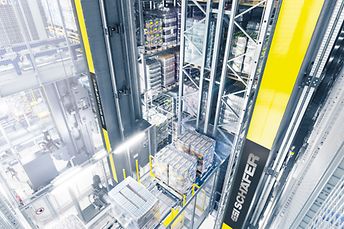Automation responds to Covid-19 impact on logistics operations
The pandemic-driven acceleration in e-commerce has brought both unprecedented opportunities and enormous challenges to global FMCG businesses. If there’s anything that the phenomenon has taught the logistics industry, it’s that the “just in time” approach simply doesn’t work anymore in this new environment. Keeping minimal stock holdings and only buying what’s necessary to service customer requirements in the short term just isn’t effective enough in the Covid era with its sea freight shortages, order profile changes, supply chain challenges and difficulties in staffing warehouses. Any slight disruption can leave a business without stock and unable to adequately supply the market.
What’s been most apparent amongst distribution centres in Australia is a rapid shift from a primarily “direct-to-store” model to a “direct-to-customer” approach. Suppliers that were formerly focused on sending numerous large orders to retail stores each week suddenly had to transition to shipping thousands of small orders straight to consumers without ever having foreseen that this was going to happen so dramatically and so quickly. A shift in business that would have been perfectly manageable over a period of years had to happen in the blink of an eye.
For many businesses, the stop-gap solution has been to run double shifts and pick stock out of stores, which has seen the overheads associated with online delivery go through the roof. In the meantime, warehouses have scrambled to respond by expanding their storage capacity in as short a timeframe as possible.
“The first enquiries we had after Covid hit were people reaching out and saying, I need more pallet racking, I need more space, I need to store more product, how can I do that?” says Brett Thirup, GM Sales & Engineering for logistics solutions provider SSI Schaefer. “That quickly turned into a question of what they could do longer term to be able to shore up their supply lines, because they didn’t have sufficient space. Covid has really seen the need to increase stock holdings due to the interruption and disruption of the supply chain, and businesses are looking for more efficient ways to store products in more automated solutions rather than manual solutions.”
While no-one could have predicted what hit the globe in 2020, FMCG players who’d already made some investments in automating their facilities were braced for the impact. Businesses that hadn’t started that journey needed those changes to be effective “yesterday”, with most DCs having already come to realise that the shift away from a heavy reliance on labour and towards more automation in their facilities is often the long-term answer. What that means, however, can be a very different proposition from one warehouse to the next.
“It’s not a cookie-cutter approach,” explains Thirup. “Most of the solutions that we provide have flexible components. We won’t sell our customers the same three widgets in a different order: we’re very much about spending a lot of time learning about their business and providing a solution that meets what they need, both for now and in the future. We actually manufacture most of what we provide – it’s not just about the equipment, but also the project management, installation, software and controls systems that can be a real driving force behind our solutions. We provide all of this through our highly experienced Australian team”
SSI Schaefer’s automated storage and picking solutions deliver an enormous bump in operational productivity. GTP solutions that bring goods to pickers rather than having them walk or drive an electric pallet jack around a DC, for example, can eliminate the time those pickers spend physically travelling to a location and searching for the item – which can take up to 60 per cent of their working hours. This type of system not only saves labour time, but is also ergonomic and provides safer working conditions.
“We try to increase the density of storage of products, something that goods-to-person systems can really help with,” says Thirup. “So traditionally, you might have a big mezzanine, with lots of walking space between items. Order cartons would be delivered by conveyors for pickers to pick into – whereas if you were to condense that into an Automated Storage and Retrieval System (ASRS) or Shuttle System with a GTP picking solution, you could have the same amount of stock on hand but significantly decrease the footprint required for it.”

The systems developed by SSI Schaefer are designed to accommodate flexibility in business activity – allowing DCs to better deal with peak days such as Black Friday events. The tailor-made, designed and delivered solutions are built sustainably so as to best future-proof the customers’ operations well past the needs of today, enabling them to conduct effective, efficient and economical materials handling both now and tomorrow.
“It’s never the same for any two customers,” says Thirup. “That’s why it’s really important to take every project on its merits and to also leverage knowledge from our own overseas market sector experts. When we start a project, it’s not just us but also our FMCG and F&B industry leaders, for example, who spend their time talking about these types of solutions across the entire global market, not just in Australia or Europe.”
Disclaimer:
This article was originally published on Inside FMCG magazine’s website on October 17, 2021. Read the original version here.

About the author:
Brett Thirup has over 25 years in the logistics automation industry, focusing heavily on sales and engineering management, project management, solution design & implementation and customer relationship management. Brett is currently the Managing Director of the Australian & New Zealand operation for SSI SCHAEFER, overseeing a strong and successful business delivering logistics automation and storage solutions and after-sales customer service & support.